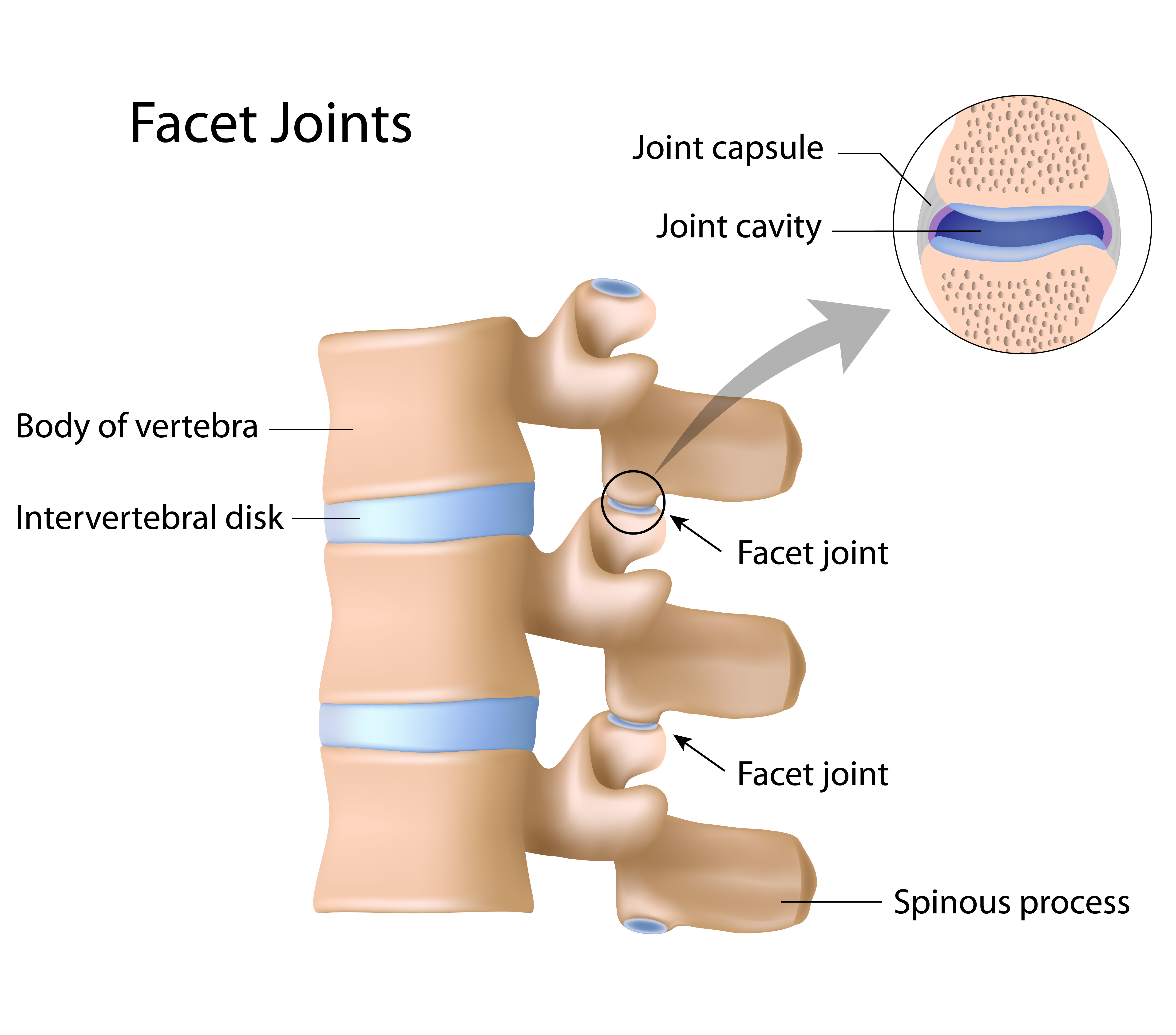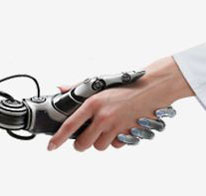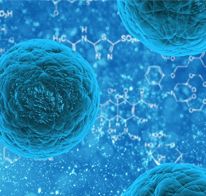Initial studies showed that facet joint pain is worse with extension and rotation of the spinal column. Other studies found increased pain during hyper-extension and rotation were not associated with relief from facet joint injection of numbing medication (pain blocks).
Location of the pain tends to be lateral and tends to radiate towards the knee, and those with central pain did not respond to pain blocks. These findings were refuted when another study concluded that knee pain was not associated with facet pain and that there are no reliable diagnostic criteria. Pain from Facet Arthropathy does not usually radiate to other areas such as the buttocks in sciatica or pain and numbness noted in spinal stenosis.
Facet Arthropathy

What is Facet Arthropathy?
Facet Arthropathy (FA) is a painful, arthritic condition of the facet joints. These joints allow for bending, twisting, and alignment of the spine. The spinal nerves come off the spinal cord between the vertebra and the facet joints. At the front the vertebra rests on a spongy contained disc while at the back each of the two facet joints rest over the facet joint below it. In a healthy spine, the spinal disc and the facet joints support each other for healthy and safe movement.
Facet Arthropathy is often associated with chronic low back pain. Low back pain potential causes include defects of the ligaments that attach the muscles to the spinal discs, compression or pinching of the spinal cord roots, the hard, protective covering of the spinal cord known as the dura, muscle disorders of the lower spine and facet joints.
Facet Arthropathy is often associated with chronic low back pain. Low back pain potential causes include defects of the ligaments that attach the muscles to the spinal discs, compression or pinching of the spinal cord roots, the hard, protective covering of the spinal cord known as the dura, muscle disorders of the lower spine and facet joints.
Patient Education Video
What Are the Symptoms of Facet Arthropathy?

What Causes Facet Arthropathy?
Facet Arthropathy can be affected by widespread arthritis of other joints seen in Ankylosing Spondylitis, Psoriatic Arthritis, and Rheumatoid Arthritis. Trauma such as small undiagnosed fractures, disc tears, cartilage splitting or haemorrhage in the area can be some associated findings.
We regularly observe patients with damaged and dysfunctional spinal discs presenting with facet joint damage at the same level in their spine. Loss of disc height and function places increased stress on the facet joints at that level, which can then cause wear and damage over time.
Osteoarthritis can cause lumbar facet pain. People with low back pain can also demonstrate X-Ray evidence of osteoarthritis. The severity of the symptoms also correlate with the degree of damage seen on the CT scan. Unusual orientation of the facet joints and enlarged ligaments can be associated with facet disease.
The synovial capsule may become distended and inflamed which puts pressure on the spinal nerves. When combined with degenerative arthritis and joint instability, pain in facet syndrome results in lower back pain. Rheumatoid arthritis is associated with damage to facets especially the mid-lumbar and lower lumbar areas.
We regularly observe patients with damaged and dysfunctional spinal discs presenting with facet joint damage at the same level in their spine. Loss of disc height and function places increased stress on the facet joints at that level, which can then cause wear and damage over time.
Osteoarthritis can cause lumbar facet pain. People with low back pain can also demonstrate X-Ray evidence of osteoarthritis. The severity of the symptoms also correlate with the degree of damage seen on the CT scan. Unusual orientation of the facet joints and enlarged ligaments can be associated with facet disease.
The synovial capsule may become distended and inflamed which puts pressure on the spinal nerves. When combined with degenerative arthritis and joint instability, pain in facet syndrome results in lower back pain. Rheumatoid arthritis is associated with damage to facets especially the mid-lumbar and lower lumbar areas.
How is Facet Arthropathy Diagnosed?
No specific X-Ray or imaging test such as CT or MRI is diagnostic of Facet Arthropathy as many of the same findings are found in asymptomatic patients. One promising test for the diagnosing this condition is the injection of anaesthetic agents into the joint. If an 80% improvement in pain occurs after the injection, a presumptive diagnosis of Facet Arthropathy can be made.
How is Facet Arthropathy Treated?
There are several options for treating the pain and symptoms caused by facet arthropathy:
1. Medications: Such as NSAIDs, Aspirin, Ibuprofen, Naproxen, and Toradol are helpful to reduce pain as are cyclo-oxygenase-2 Inhibitors such as Celecoxib, and analgesics Acetomenophen, known as Paracetamol or Tylenol.
2. Non-surgical treatments: Physical therapy, strengthening exercises, avoiding movements that aggravate the symptoms, and medications such as NSAIDs like ibuprofen and naproxen can be used.
Intra-joint injections and medial branch blocks of steroids/numbing medication under radiographic guidance and radiofrequency (RF) ablation to block the sensation of pain are two standard therapies. It appears that medial branch blocks and RF ablation are the best options with the lowest complication rates.
Shockwave therapy is another therapy that appears to be better than steroid injections and as effective as RF ablation with better long-term outcomes. Shockwave therapy uses the same technology that breaks up kidney stones. The idea of this therapy is to percussive therapy to create micro traumas in the afflicted tissues, in order to invoke a repair response from your body.
3. Stem Cell Regeneration: Stem cell regeneration is a non-invasive and experimental treatment for damaged and painful facet joints. For many years patients have achieved promising results from targeted stem cell treatments of the hip and knee joints, and in the facet joint this is also possible. During the treatment, stem cells are carefully injected into the facet joints under CT imaging guidance by an orthopaedic specialist. The cells respond to inflammatory signals from the arthritic joint and start working to repair and regenerate the joint. This can be assisted with shockwave therapy (mentioned above) and other supportive therapies.
4. Spine Surgery: For patients who have exhausted conservative therapies, surgery may be an option to relieve the pain of facet arthropathy - in cases of nerve compression, spinal stenosis, spinal instability and associated motor or sensory symptoms.
Our German Spine Specialists are experienced with “Total Lumbar Facet Replacement”, which is a new motion-preserving solution where the facet joints are removed and replaced with artificial joints. This restores healthy height and movement to the damaged part of the spine.
For mild to moderate Facet Arthropathy presenting with a degenerative spinal disc at the same level, Artificial Disc Replacement is also an option. The controlled movement of the New-Generation ESP & M6 Artificial Discs protect the facet joints, and when natural height and movement is re-introduced to the damaged spinal level with ADR, then we observe cases where Facet Joint rehabilitation is possible.
If the patient is not a candidate for a motion-preserving solution, then a spinal fusion can be offered as a ‘last line of defence’. In most forms of a spinal fusion, the surgeon removes the facet joints between the levels of the spine that are to be fused together, which effectively eliminates the facet joints as a source of future symptoms.
1. Medications: Such as NSAIDs, Aspirin, Ibuprofen, Naproxen, and Toradol are helpful to reduce pain as are cyclo-oxygenase-2 Inhibitors such as Celecoxib, and analgesics Acetomenophen, known as Paracetamol or Tylenol.
2. Non-surgical treatments: Physical therapy, strengthening exercises, avoiding movements that aggravate the symptoms, and medications such as NSAIDs like ibuprofen and naproxen can be used.
Intra-joint injections and medial branch blocks of steroids/numbing medication under radiographic guidance and radiofrequency (RF) ablation to block the sensation of pain are two standard therapies. It appears that medial branch blocks and RF ablation are the best options with the lowest complication rates.
Shockwave therapy is another therapy that appears to be better than steroid injections and as effective as RF ablation with better long-term outcomes. Shockwave therapy uses the same technology that breaks up kidney stones. The idea of this therapy is to percussive therapy to create micro traumas in the afflicted tissues, in order to invoke a repair response from your body.
3. Stem Cell Regeneration: Stem cell regeneration is a non-invasive and experimental treatment for damaged and painful facet joints. For many years patients have achieved promising results from targeted stem cell treatments of the hip and knee joints, and in the facet joint this is also possible. During the treatment, stem cells are carefully injected into the facet joints under CT imaging guidance by an orthopaedic specialist. The cells respond to inflammatory signals from the arthritic joint and start working to repair and regenerate the joint. This can be assisted with shockwave therapy (mentioned above) and other supportive therapies.
4. Spine Surgery: For patients who have exhausted conservative therapies, surgery may be an option to relieve the pain of facet arthropathy - in cases of nerve compression, spinal stenosis, spinal instability and associated motor or sensory symptoms.
Our German Spine Specialists are experienced with “Total Lumbar Facet Replacement”, which is a new motion-preserving solution where the facet joints are removed and replaced with artificial joints. This restores healthy height and movement to the damaged part of the spine.
For mild to moderate Facet Arthropathy presenting with a degenerative spinal disc at the same level, Artificial Disc Replacement is also an option. The controlled movement of the New-Generation ESP & M6 Artificial Discs protect the facet joints, and when natural height and movement is re-introduced to the damaged spinal level with ADR, then we observe cases where Facet Joint rehabilitation is possible.
If the patient is not a candidate for a motion-preserving solution, then a spinal fusion can be offered as a ‘last line of defence’. In most forms of a spinal fusion, the surgeon removes the facet joints between the levels of the spine that are to be fused together, which effectively eliminates the facet joints as a source of future symptoms.
Surgery & Treatment for Facet Arthropathy
At Spine Connection we have regenerative and surgical treatments for all spine conditions. As every case is unique we encourage you to receive and compare opinions from our Neurosurgeon and Orthopedic Spine Specialists. We are here to help.
Begin My Assessment
Ask Our Doctors
Join Our Youtube Channel
Watch videos showcasing the latest technologies and surgery techniques, and keep up to date with patient stories from around the globe.








